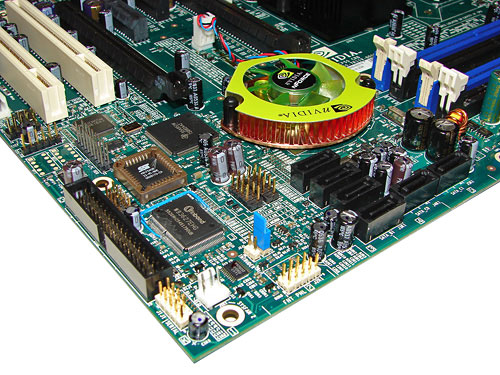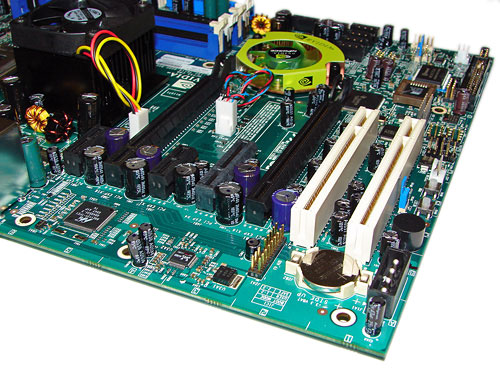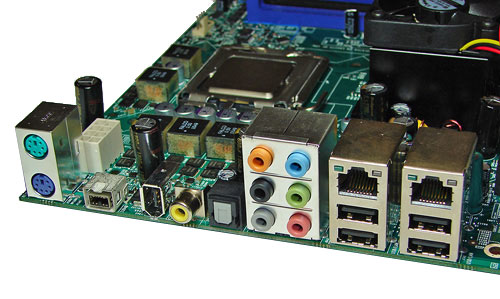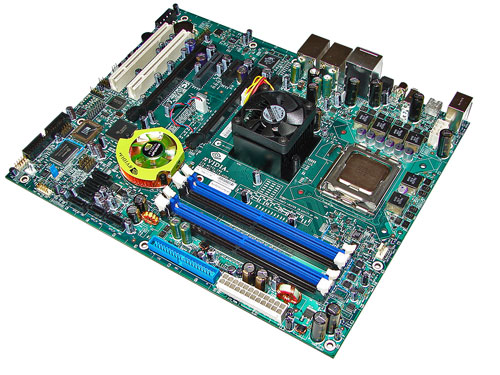nForce 590 SLI Intel Edition: NVIDIA prepares an Intel 975X Killer
by Gary Key on June 27, 2006 6:15 AM EST- Posted in
- CPUs
NVIDIA nForce 590 SLI: Reference Board Layout
NVIDIA designed a very well laid out board with all major connections easily reached. The board is lacking most clearance issues and was very easy to install in our mid-size ATX case. The reference board features an excellent voltage regulator power design along with Rubycon and Sanyo capacitors that yielded superb stability and overclocking results even with our early BIOS and board design.

The DIMM module slots' color coordination is correct for dual channel setup based upon the premise of utilizing different colors for each memory bank. The memory modules are easy to install with a full size video card placed in the first PCI Express X16 slot. The 24-pin ATX power connector is located along the upper edge of the board along with the single IDE port connector.

The six NVIDIA SATA ports are color coded black and are conveniently located below the NVIDIA MCP. The SATA ports feature the newer clamp and latch design. We found the positioning of the SATA ports to be excellent when utilizing either PCI-E X16 slot. The NVIDIA MCP does require a heatsink in this application.
The floppy drive connector is color coded black while being positioned along the left edge of the board. The location of this connector is not ideal and actually the whole point of having a floppy drive connector is becoming moot with the wide spread availability of USB floppy or flash drives along with BIOS support for boot purposes. The various chassis panel, USB connectors, and the second chassis fan header are located in the lower left portion of the board.

The board comes with (2) physical PCI Express X16 connectors, (1) PCI Express X1 connector, (1) PCI Express X4 connector, and (2) PCI 2.3 connectors. The layout of this design offers a very good balance of expansion slots for a mainstream board while providing excellent clearance space for graphics card utilization. Our main issue is that the first PCI 2.3 connector will be rendered physically useless if an SLI setup is utilized. Although the positioning and number of PCI-E and PCI slots are up to the manufacturer, we certainly hope to see better layouts that do not block the PCI slots in the near future. A four-pin molex power connector that is required for SLI operation and the first chassis fan header is located along the edge of the board. The four-pin molex connector is located in an unusual and difficult location to reach, the bottom left corner.
Returning to the CPU socket area, we find an ample amount of room for alternative cooling solutions. We utilized the stock heatsink/fan in our normal testing but also verified a couple of larger Socket 775 cooling solutions would fit in this area during our overclocking tests.
The NVIDIA SPP is actively cooled with a medium sized heatsink/fan unit that did not interfere with any installed peripherals. In fact this unit kept the chipset cool enough that additional chipset voltage was not a factor in our overclocking tests, although we could see this unit heating up if the HSF is not seated properly. Our only concern is the lifespan of the fan but it is very quiet during operation. NVIDIA places the 8-pin 12V auxiliary power connector at the top of the CPU socket area but out of the way of aftermarket cooling solutions.

The rear panel contains the standard PS/2 mouse and keyboard ports, LAN ports, and 4 USB ports. The LAN (RJ-45) ports have two LED indicators representing activity and speed of the connection. The audio panel consists of 6 ports that can be configured for 2, 4, 6, and 8-channel audio connections. The rear panel also includes two S/PDIF (optical/coaxial) ports, an external SATA 3Gb/s port, and an IEEE 1394a port.
 |
| Click to enlarge |
NVIDIA designed a very well laid out board with all major connections easily reached. The board is lacking most clearance issues and was very easy to install in our mid-size ATX case. The reference board features an excellent voltage regulator power design along with Rubycon and Sanyo capacitors that yielded superb stability and overclocking results even with our early BIOS and board design.

The DIMM module slots' color coordination is correct for dual channel setup based upon the premise of utilizing different colors for each memory bank. The memory modules are easy to install with a full size video card placed in the first PCI Express X16 slot. The 24-pin ATX power connector is located along the upper edge of the board along with the single IDE port connector.

The six NVIDIA SATA ports are color coded black and are conveniently located below the NVIDIA MCP. The SATA ports feature the newer clamp and latch design. We found the positioning of the SATA ports to be excellent when utilizing either PCI-E X16 slot. The NVIDIA MCP does require a heatsink in this application.
The floppy drive connector is color coded black while being positioned along the left edge of the board. The location of this connector is not ideal and actually the whole point of having a floppy drive connector is becoming moot with the wide spread availability of USB floppy or flash drives along with BIOS support for boot purposes. The various chassis panel, USB connectors, and the second chassis fan header are located in the lower left portion of the board.

The board comes with (2) physical PCI Express X16 connectors, (1) PCI Express X1 connector, (1) PCI Express X4 connector, and (2) PCI 2.3 connectors. The layout of this design offers a very good balance of expansion slots for a mainstream board while providing excellent clearance space for graphics card utilization. Our main issue is that the first PCI 2.3 connector will be rendered physically useless if an SLI setup is utilized. Although the positioning and number of PCI-E and PCI slots are up to the manufacturer, we certainly hope to see better layouts that do not block the PCI slots in the near future. A four-pin molex power connector that is required for SLI operation and the first chassis fan header is located along the edge of the board. The four-pin molex connector is located in an unusual and difficult location to reach, the bottom left corner.
 |
| Click to enlarge |
Returning to the CPU socket area, we find an ample amount of room for alternative cooling solutions. We utilized the stock heatsink/fan in our normal testing but also verified a couple of larger Socket 775 cooling solutions would fit in this area during our overclocking tests.
The NVIDIA SPP is actively cooled with a medium sized heatsink/fan unit that did not interfere with any installed peripherals. In fact this unit kept the chipset cool enough that additional chipset voltage was not a factor in our overclocking tests, although we could see this unit heating up if the HSF is not seated properly. Our only concern is the lifespan of the fan but it is very quiet during operation. NVIDIA places the 8-pin 12V auxiliary power connector at the top of the CPU socket area but out of the way of aftermarket cooling solutions.

The rear panel contains the standard PS/2 mouse and keyboard ports, LAN ports, and 4 USB ports. The LAN (RJ-45) ports have two LED indicators representing activity and speed of the connection. The audio panel consists of 6 ports that can be configured for 2, 4, 6, and 8-channel audio connections. The rear panel also includes two S/PDIF (optical/coaxial) ports, an external SATA 3Gb/s port, and an IEEE 1394a port.










37 Comments
View All Comments
PedroDaGr8 - Tuesday, June 27, 2006 - link
Looks good to me now.DigitalFreak - Tuesday, June 27, 2006 - link
Came across this article on The Inquirer - http://www.theinquirer.net/?article=32592">link, that states that the 590 SLI Intel chipset is still using the old C19 northbridge from the NF4 Intel boards, and not the C51XE. Unless I'm missing something, the CPU-Z mainboard shot on page 4 confirms this (C19MCP55).eastvillager - Tuesday, June 27, 2006 - link
I'm not buying another motherboard with active cooling on the chipset, much less TWO active cooling systems(MCP and SPP). I'm sick of fans that die within a year, sound like banshees, and are a pain in the ass to replace.Frumious1 - Tuesday, June 27, 2006 - link
NVIDIA's nf% NB runs pretty hot, and I'd rather have a small fan making sure it doesn't overheat. It's amazing what a moderate fan can do for temperatures. Passive cooling sounds great until you live in a house without AC that hits over 100 F in the summer. I've got a passively cooled mobo that I had to juryrig a fan only in order to keep it running in the summer. As for the SB, you can't have just a tiny heatsink ehen you're likely to have two big 7900 cards sitting above it.Now, give us the ASUS version with heatpipes and a nice fan on the final VRM radiator, and we'll be fine. This is a reference board, you know? As in, you can't even buy it and few manufacturers will use the exact cooling setup that NVIDIA chose here. My question is: if this is a reference board 1 month before Conroe, when will retail boards show up? Probably still before ATI AM2 boards, but hopefully before Conroe even ships.
psychobriggsy - Tuesday, June 27, 2006 - link
The nForce chipsets for the K8 use a lot more power than ATI's chipsets.How do they compare on the Intel platform, vs. ATI and Intel chipsets?
Gary Key - Tuesday, June 27, 2006 - link
We will have power consumption numbers in our next article for Intel and NVIDIA. We need to receive the revised board before publishing the numbers. We do not have the ATI RD600 for Intel yet so those numbers will not be available for a few more weeks.
phusg - Tuesday, June 27, 2006 - link
Here here, I'd like to see this looked into too! Cheers, PeteAnemone - Tuesday, June 27, 2006 - link
The Nvidia board does not have better memory performance than the 975x. All of the tests where the Nvidia board lost were memory related. And moreover, it is already known that the same memory controller from the NF4 is being used on the NF5. Run a couple of memory bandwidth tests and you'll see that the NF5 only has about 2/3-3/4 of the memory bandwidth of the 975x. What the NF5 does have is SLI and a very good disk subsystem. But the disk subsystem has its ups and downs as you started to see. Give that a more thorough workout and you'll see it's not all roses either.There are a handful of tests ongoing on the NF5 boards around the web and they aren't favorable vs the 975x. The overall conclusing about the NF4 was that you buy an Intel chipset for an Intel chip if you wanted the most stable environment. Maybe, and only maybe, they manage to dress this horse up to run a bit, but after the disk corruption issues of the NF4, the memory stability issues while overclocking on the Intel version, and the heavy possibility that all those things are still around for us in this new version, I'm doubtful a lot of folks are going to spend a few hundred dollars to find out things we already knew about the NF4.
And if Nvidia wants to continue to fool itself and its shareholders that they "can't run SLI on Intel" and cut off that sales avenue, well that's going to make ATI very well off indeed over the next year. Because the reviews of the 975x are fantastic, and Conroe flies, and sooner or later a lot of folks are going to say what kind of dual DX10 gpu can I put in this board and if it's not possible to be Nvidia, that will leave one answer come Vista time when everyone thinks about graphics horsepower.
Don't think the NF5 is going to be the runner some hoped it would be. And I don't think after a few more weeks quite a few folks are going to "take a chance" after the fiasco that was the NF4, and try the NF5.
Frumious1 - Tuesday, June 27, 2006 - link
Tried? What do you mean "nice try"!? Seems to me you're basing all of your criticisms off of past experience on nF4. The AT crew reported that drive corruption issues were never experienced in their nF5 testing. (Personally, I've never seen it anyway, but I guess I just don't do as much weird stuff as some people. I'm quite happy without the NVIDIA firewall and RAID.)Anyway, this is a preview of a chipset that supports - actually, truly SUPPORTS! - Core 2 Duo. No guessing this time. Yay! It also supports SLI, and while 975X support CF, don't even get me started about the BS driver wars between ATI and NVIDIA. The reason ATI supports CF on 975X is because they don't have a freaking Intel chipset that works worth shit! Hmm... those ATI AM2 chipsets sound nice in theory, but they're still not on the market. If ATI were smart, they's support the superior NVIDIA chipsets with CrossFire - not superior in temperatures, perhaps, but at least the damn things are available!
Anyway, I don't know what "fiasco" you're talking about with nF4. If by "fiasco" you mean "clearly the best AMD 939 chipset on the market, with stellar sales, great performance, and nice features - with a few odd exceptions experienced by people that probably wanted to use extreme overclocks, run RAID 0, run the Firewall, and do all this with a questionable power supply" then I suppose it was a fiasco. For 99.9% of the market, nF4 worked and continues to work great. Nforce3 was perhaps a "fiasco", as was GeForce 5xxx; nForce4 has a few minor flaws that fucking nitpicks can't get over.
Meanwhile, let's not even talk about the bullshit 915/925 to 945/955 to 975 upgrade path that Intel chipsets have taken. You want a real fiasco? Let's talk about the fact that some 975X motherboards won't support Conroe. Let's talk about the lack of shipping 965 motherboards. Let's talk about the forced upgrades to "dual core capable" chipsets that appear to be as marketing driven as NetBurst. Or let's talk about ATI's complete lack of compelling Intel chipsets, their frequently delayed AMD chipsets, and their lame-duck DVI dongle cable for CrossFire.
Personally, I found this to be a nice article looking at an interesting CPU. How AnandTech managed to get a 3940 MHz overclock out of the 305, I'd like to know. Mine craps out at about 3.6 GHz. Still damn nice for a CPU that can be purchased with a motherboard for about $125 (Frye's sale). I just wish there were some OC performance results posted, and perhaps COD2 numbers. (COD2 with the "SLI Optimization" enabled, as that's really what enables SMP support. Stupid Activision/Grey Matter - and the damn setting isn't even saved between game runs. You have to manually reenable every time!)
Anyway, pay no heed to this whiner, AnadnTech - I thought this was a cool article.
Anemone - Tuesday, June 27, 2006 - link
Ok if you read the comment below you'll note they used the NF4 memory controller. Since that was subject to a lot of problems on the NF4 for Intel (not the AMD version) it's a more than decent bet there are still going to be issues. You want to run at stock then by all means the NF5 should be fine. I don't know too many folks running SLI who insist on running at stock however, so I'll take a decent bet that many purchasers of the NF5 are not running stock.Article 1: http://www.neoseeker.com/Articles/Hardware/Preview...">http://www.neoseeker.com/Articles/Hardware/Preview...
"corrupted the registry twice while fiddling with the FSB"
Hmm, I've managed to corrupt the registry once on an Intel board and that was an old one from years ago. I'm thinking an experienced tester stumbling on that twice might be pushing the envelope or might have a crummy board. Read the conclusions for more fun.
Article 2: http://www.hothardware.com/viewarticle.aspx?articl...">http://www.hothardware.com/viewarticle.aspx?articl...
This is a newer article seemingly after the board has had a chance to get a bit more up to speed. Read the conclusing and you'll find they think you probably want to let the board mature a bit.
Article 3: http://www.bit-tech.net/hardware/2005/07/29/p4n_ga...">http://www.bit-tech.net/hardware/2005/07/29/p4n_ga...
"Unfortunately we found the NVIDIA chipset didn’t enjoy overclocking as much as we’d have hoped"
Article 4: http://www.hardocp.com/article.html?art=MTAyOSw3LC...">http://www.hardocp.com/article.html?art=MTAyOSw3LC...
"yet to see a real reason to purchase an Intel processor based motherboard without an Intel chipset at the heart of the machine"
Perhaps there might be an issue or two with the Intel variety of the NF4 and then realize that the very same memory controller, which is at the heart of most of the issues with the NF4, is also on the NF5.
Go to Xtremesystems forums or the H forums if you like and read up. Many folks have had issues, much like the reviewers. Why those and then Anand gets a wonderful review? I've no idea. But another tester of an early board never got above 227mhz fsb. So it's pretty certain the same issues that plagued the NF4 are here in a new wrapper to plague us again.